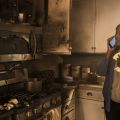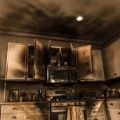How To Put Out Different Classes of Fires
4nov 2021

Call us today at 239-431-9947 or contact us online to learn more about our complete fire damage restoration services.
While there are several ways a fire can start, there’s one thing you need to do if a fire occurs – act quickly. A fire can go from a spark to engulfing flames in no time, so every second counts. Educating yourself now on different types of fires and how to put them out means protecting your family in the future if something does occur.
As a note, while the following scenarios give tips for extinguishing a fire yourself, if the problem is serious or spreads quickly, call your fire department immediately or dial 911.
Learn About Fires
- Fire is FAST! In less than 30 seconds a small flame can turn into a major fire. It only takes minutes for thick black smoke to fill a house or for it to be engulfed in flames.
- Fire is HOT! Heat is more threatening than flames. Room temperatures in a fire can be 100 degrees at floor level and rise to 600 degrees at eye level. Inhaling this super-hot air will scorch your lungs and melt clothes to your skin.
- Fire is DARK! Fire starts bright, but quickly produces black smoke and complete darkness.
- Fire is DEADLY! Smoke and toxic gases kill more people than flames do. Fire produces poisonous gases that make you disoriented and drowsy. Asphyxiation is the leading cause of fire deaths, exceeding burns by a 3-to-1 ratio.
Classes of Fire
- Class A - involve common combustibles such as wood, paper, cloth, rubber, trash and plastics.
- Class B - involve flammable liquids, solvents, oil, gasoline, paints, lacquers and other oil-based products.
- Class C - involve energized electrical equipment such as wiring, controls, motors, machinery, or appliances.
- Class D - involve combustible metals such as magnesium, lithium and titanium.
- Class E - fires cause by live electrical apparatus.
- Class K - involve combustible cooking media such as oils and grease commonly found in commercial kitchens
How To Put Out Wood Fire
Wood burning fires typically stem from a fireplace or fire pit and are categorized as Class A fires – or a fire that uses flammable material as its fuel sources. Wood, paper, trash, fabric and plastics are also common sources of Class A fires.
If a fire originating from your indoor fireplace gets out of hand, here are some dos and don’ts on how to put out a wood burning fire:
- Do: Use a fireplace poker to spread out the wood and embers.
- Do: Extinguish the flames using the ash from your embers once they cool down.
- Do: Put a layer of banking soda over the ash once the fire is out to eliminate any remaining embers. This adds an additional layer that prevents oxygen from reaching the embers.
- Don’t: Remove the burning logs. Doing so increases the risk of the fire spreading to other parts of your home as you attempt to remove it.
- Don’t: Douse the flames with water in a fireplace or in an enclosed room unless this is a serious emergency and there’s no other option. Using water creates massive amounts of smoke and can cause steam burns. It can also damage your fireplace leading to cracks and heaves due to the sudden change in temperature.
How To Put Out Outdoor Fire Pit
- Extinguish the fire with water. Compared to fireplaces, outdoor fire pits are often in more open spaces which allows for steam or smoke to go away when extinguished.
- Spread the wood and embers to create ash, similar to how you would handle a fireplace fire.
- Put sand over the burning embers. Make sure you spread a thin layer of sand on the embers to prevent them from having access to oxygen. Adding too much sand can cause the embers to remain lit underneath, which poses a fire hazard if they’re uncovered by wind.
- Use a Class A fire extinguisher if the fire gets out of hand. If the steps above do not take effect and the fire appears to be out of control or in danger of spreading, call 911 for help.
How To Put Out Gas Fire
Fires caused by natural gas, kerosene, propane or gasoline are categorized as Class B fires. These types of fires are caused by flammable liquids and best extinguished by smothering.
- Do not use water to put out a gas fire. It will only make the situation worse.
- Use a Class B fire extinguisher instead which is made to put out a gas fire.
- After the fire is controlled, shut off the gas flow on the appliance and notify your utility company.
- Do not turn back on the appliance until the situation has been properly handled.
How To Put Out Electrical Fire
Speaking of appliances, if they’re connected to electrical outlets, it’s possible for them to catch fire. There are specific steps you can take to handle a fire resulting from a home wiring failure, worn out breaker box, appliance malfunction or frayed electrical cord.
Here’s how you can put out an electrical fire:
- If possible, unplug the appliance. Doing so will help reduce the risk of the fire spreading while also ensuring the appliance does not pose additional risk to those attempting to put out the electrical fire.
- Use Type C fire extinguisher that has a ‘C’ on its label.
- If the electrical fire is small, smother the flames with baking soda. This will reduce the oxygen that the fire has access to, potentially putting it out. However, if the electrical fire starts to grow out of control, call 911 for help.
How To Put Out Appliance Fire
There are also the home appliances that aren’t connected to an electrical outlet but can still cause fire, like your oven, stove and microwave. These appliances are often located in the kitchen, where high temperatures place them at an increased risk of catching on fire.
There are some specific steps you should follow if you’re want to know how to put out an appliance fire:
To put out an oven fire:
- Leave the oven door closed. This prevents oxygen from fanning the flames and helps avoid flames from reach other areas of your kitchen.
- Turn off the oven. This will prevent the fire from spreading to the outlet where it can quickly spread throughout your home.
- Do not put water on the flames. If the oven is plugged in, this will cause electricity to electrocute the person throwing the water on the flames.
- Use a Class C fire extinguisher. This will help smother the oven fire and help put it out.
How To Put Out Stove Fire
- Make sure all burners are turned off. Having a burner on will only help fuel the stove fire, making it harder to put out the flames.
- Move everything away from the stovetop area
- Unplug appliances near the stove. Less items near the oven means that the stove fire has less items to potentially spread to.
- Do not use water to douse the flames. Electricity travels through water quickly and may electrocute you.
- Use a Class C fire extinguisher.
How To Put Out Microwave Fire
- Unplug the appliance or turn off the kitchen’s circuit breaker.
- Move everything away from the microwave area
- Use a Class C fire extinguisher.
How To Put Out Grease Fire
Cooking fires are the top cause of home fires and injuries. Of these fires, the majority begin with oil becoming too hot, boiling and eventually turning from smoke into flames. These are called grease fire, or Class K fires.
Here’s how to put out a grease fire:
- Cover the fire immediately. You can use a lid or cookie sheet to put out a grease fire. Leave this cover on until the flames are gone and the metal is cool to the touch. This helps prevent oxygen from continuing to fuel the fire.
- Turn off the heat source. Turning off the stove or burners used will prevent the grease or oil from continuing to be heated. While this will help, do not remove the pan from the stove. You may drop the pan or cause burning grease to spread throughout your home, placing yourself at risk of harm.
- Do not pour water on the fire. It can cause the grease to splash and the flames to spread. This is caused by the water vaporizing in the intense heat, causing grease to splash as the water vapor escapes.
- Using a Class K fire extinguisher should be your last resort. A grease fire can be difficult to put out without the proper tools. If you don’t have a class K fire extinguisher, call 911.
WHAT SHOULD YOU DO IF YOU CAN’T EXTINGUISH A FIRE?
If a fire becomes uncontrollable, leave your house immediately. Close the door as you leave to try to contain the flames. Once you’re safe, call 911 and do not go back inside your home until you’re told by a professional – like a firefighter – that the area is safe for reentry.
Contact Most Trusted Fire Damage Restoration Company in Southwest, Florida
Fires spread quickly and failure to act quickly could lead to structural damage and health issues. However, fire damage is not the only concern, since smoke damage and soot can also spread in your home which will lead to ongoing issues with odors and corrosion to different surfaces and contents.
Fires spread quickly and failure to act quickly could lead to structural damage and health issues. However, fire damage is not the only concern, since smoke damage and soot can also spread in your home which will lead to ongoing issues with odors and corrosion to different surfaces and contents.
ServiceMaster by Wright offers water damage restoration, mold removal, content cleaning and restoration, fire damage repairs, packout and content storage, tarping and board up and reconstruction services. We’ll work with you to recover what can be recovered, while ensuring that you have the support you need during the process.
Related items:
11/17/2020
How to Prevent Office Kitchen Fires
Commercial kitchen fires are something that need to be taken seriously. ServiceMaster by Wright discusses six important tips to prevent office kitchen fires to protect the employees and the business.
11/24/2020
Fire Safety Tips for Thanksgiving
Essential steps must be taken to protect the home from a fire incident this Thanksgiving. ServiceMaster by Wright discusses important fire safety tips to prevent residential fires in this article.
10/15/2020
How to Remove Cooking Grease After a Protein Fire
Cooking is often the leading cause of all residential building fires and injuries. In observance of fire safety, ServiceMaster by Wright will discuss the steps to remove grease after protein fires.
 3/21/2021
Is It Safe to Stay in a House With Smoke Damage?
3/21/2021
Is It Safe to Stay in a House With Smoke Damage?
Fire incidents leave harmful effects. Learn about safety concerns regarding staying in a smoke-damaged house in this article by ServiceMaster by Wright.
 5/21/2021
How to Prepare Youth for Emergencies and Disasters
5/21/2021
How to Prepare Youth for Emergencies and Disasters
Learn how to prepare youth for emergencies. For Florida water, fire, and storm damage restoration, call ServiceMaster by Wright at (239) 431-9947.